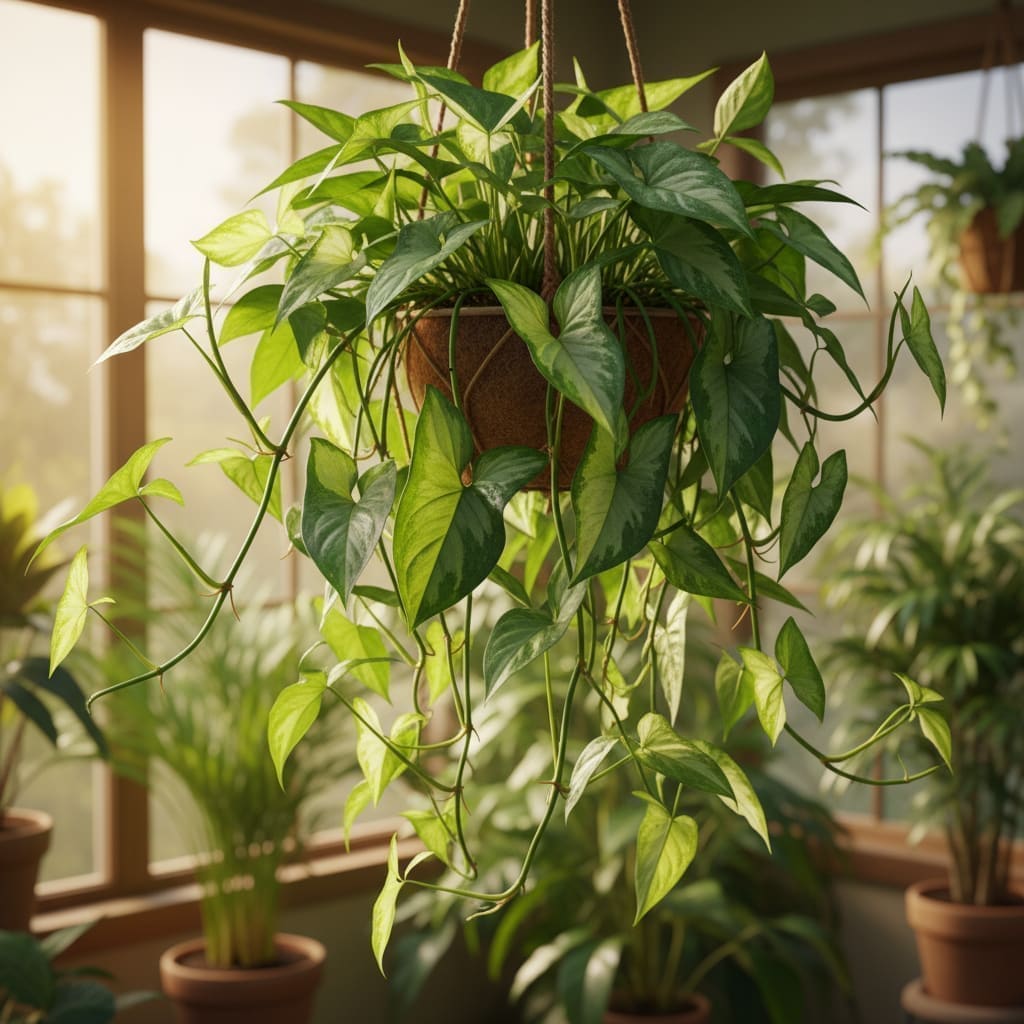Syngonium podophyllum (Arrowhead Vine) Care Guide
Overview
Syngonium podophyllum, commonly known as the Arrowhead Vine, is a versatile and attractive tropical houseplant native to Latin America, ranging from Mexico to Bolivia. It is prized for its lush foliage, which changes shape as the plant matures—from simple arrow-shaped leaves to more complex, lobed forms. This plant is adaptable to a variety of indoor settings and can be grown as a compact bushy plant or trained to climb with support.
With proper care, the Arrowhead Vine can thrive for many years, adding vibrant greenery to homes and offices. It is considered moderately easy to care for, making it suitable for both beginners and experienced plant keepers.
Identification & Growth Habit
The Arrowhead Vine is a trailing or climbing plant in the Araceae family. Young plants typically have upright stems with arrow-shaped leaves, while mature specimens develop longer vines that can trail from hanging baskets or climb supports such as moss poles or trellises.
- Leaf shape: Juvenile leaves are arrowhead-shaped; mature leaves may become lobed or divided.
- Leaf color: Varieties range from solid green to variegated patterns in white, cream, pink, or light green.
- Growth rate: Moderate to fast under ideal conditions.
- Habit: Can be grown as a tabletop plant, in hanging baskets, or trained vertically.
Light & Placement
Place your Syngonium podophyllum in bright, indirect light to maintain vibrant foliage and healthy growth. Direct sun can scorch leaves, while prolonged low light may cause leggy stems and reduced variegation.
- Ideal placement: Near an east- or north-facing window, or a few feet back from a bright south- or west-facing window with sheer curtains.
- Avoid: Harsh midday sun and very dim corners.
Watering & Humidity
Water when the top 1–2 inches (2.5–5 cm) of soil feel dry to the touch. Overwatering can lead to root rot, so always check moisture before watering. Reduce frequency in winter when growth slows.
- Humidity: Prefers 50–60% relative humidity.
- Tips: Use a humidifier, pebble tray, or occasional misting to boost humidity in dry environments.
Soil & Repotting
Use a well-draining soil mix such as equal parts potting soil, perlite, and peat moss or coco coir. Ensure the container has drainage holes to prevent waterlogging.
- Repot every 1–2 years or when roots become crowded.
- Spring is the best time to repot, allowing the plant to recover during the active growth season.
Fertilizing
Feed monthly during spring and summer with a balanced, water-soluble fertilizer diluted to half strength. Avoid fertilizing in fall and winter when the plant’s growth naturally slows.
Pruning & Training
Regular pruning helps maintain the desired shape and encourages bushier growth. Use clean, sharp scissors or pruners to trim leggy stems just above a node.
- For trailing plants: Allow stems to cascade from shelves or baskets.
- For climbing plants: Train vines onto a moss pole or trellis, securing them gently with plant ties.
Propagation
Syngonium podophyllum is easy to propagate via stem cuttings. Follow these steps:
- Select a healthy stem with at least one node and a few leaves.
- Cut just below the node using sterilized scissors or pruners.
- Place the cutting in a jar of water or directly into moist, well-draining soil.
- If rooting in water, change the water every few days to keep it fresh.
- Once roots are 1–2 inches long, transfer to a pot with suitable soil.
Common Problems
Pests
- Spider mites: Look for fine webbing and speckled leaves. Treat with insecticidal soap or neem oil.
- Aphids and mealybugs: Remove with a cotton swab dipped in alcohol or use a gentle insecticidal spray.
Diseases
- Root rot: Caused by overwatering or poor drainage. Remove affected roots and repot in fresh soil.
- Leaf spot: Often due to fungal infection; remove affected leaves and improve air circulation.
Physiological Issues
- Yellow leaves: Usually from overwatering or poor drainage.
- Leggy growth: Indicates insufficient light.
Toxicity & Pet Safety
Syngonium podophyllum is considered toxic to cats, dogs, and humans if ingested, due to the presence of calcium oxalate crystals. Keep out of reach of pets and children, and handle with care to avoid skin irritation from sap.
Styling & Decor Tips
- Use hanging baskets to showcase trailing vines.
- Train up a moss pole for a vertical, tropical display.
- Pair with other tropical foliage plants for a lush indoor jungle look.
- Choose decorative pots that complement the leaf variegation.
Varieties & Cultivars
Popular cultivars of Syngonium podophyllum include:
- ‘Albo Variegatum’: Green leaves with white or cream marbling.
- ‘Neon Robusta’: Bright pinkish leaves with green undertones.
- ‘Pixie’: A compact variety with small green and cream leaves.
- ‘Maria Allusion’: Coppery-pink tones with green margins.
Buying Tips & Maturity
- Look for healthy, pest-free foliage with no yellowing or brown spots.
- Check that the plant is well-rooted but not root-bound.
- Young plants are bushier; mature plants may have longer vines and more complex leaves.
Seasonal Care
- Spring/Summer: Active growth period; water and fertilize regularly, and consider repotting or pruning.
- Fall/Winter: Growth slows; reduce watering and stop fertilizing. Maintain adequate light and avoid cold drafts.
FAQ
- How fast does Syngonium podophyllum grow? Under ideal conditions, it has a moderate to fast growth rate, producing new leaves regularly in spring and summer.
- Can it grow in low light? It can tolerate low light but may lose variegation and become leggy; bright, indirect light is best.
- Should I mist my Arrowhead Vine? Occasional misting can help maintain humidity, but avoid keeping leaves constantly wet to prevent fungal issues.
- Can I grow it outdoors? In warm, frost-free climates, it can be grown outdoors in shaded areas; otherwise, keep it indoors as a houseplant.
- Why are my plant’s leaves turning brown at the tips? This may be due to low humidity, underwatering, or a buildup of salts from fertilizer; adjust care accordingly.
Sources: Wikipedia, The Spruce






